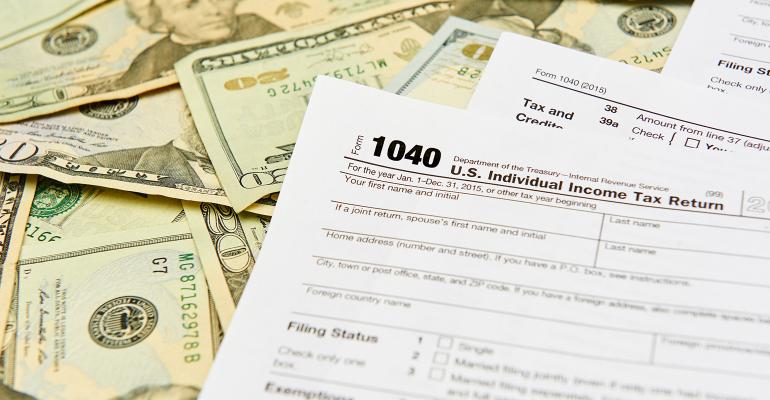(Bloomberg) -- Taking investment losses doesn’t feel good, but done right, it can lower your tax bill and boost after-tax returns.
Tax-loss harvesting is the wonky term for a strategy that lets you use losses to offset taxes on capital gains owed when you sell at a profit. Those investment losses can offset gains not just from other securities, but from gains on the sale of a home or business.
Even with the S&P 500 up more than 20% in 2023, investors can still use this strategy, according to Mary Lukic, head of tax-advantaged equity at Northern Trust Asset Management.
“We see plenty of opportunity to lock in losses before yearend,” she said. More than a third of S&P 500 securities are in the red.
Not only can losses help manage capital gains, they may be used to offset ordinary income. If you have losses but no capital gains, or have net losses even after offsetting capital gains, some of those losses can be deducted against ordinary income, up to $3,000 a year. Losses you don't use in one year can be carried forward indefinitely for future use as well.
“We think of this as a year-round strategy,” said Monali Vora, head of wealth investment solutions at Goldman Sachs Asset Management. “You can do it almost every month, subject to the market.”
Vora and Lukic both said that tax-loss harvesting can add between 1% to 2% to after-tax returns annually.
How It Works
Depending on how long you’ve held a stock, capital gains taxes can be pretty painful.
Tax on long-term gains — positions held for more than a year — is either 0%, 15% or 20%, depending on your taxable income and filing status. Positions held for a year or less, however, are taxed as ordinary income. For top earners, that’s a 37% federal rate, and capital gains taxes in high-tax states such as New Jersey, New York and California can push the rate to around 50%.
Read more: What You Need to Know About IRS Tax Changes for 2024
Moreover, tax-loss harvesting is more than just selling losers to offset gains. The idea is to sell losers and then replace them with holdings that keep your portfolio with the same overall composition — the same exposure to certain industries, or in line with any benchmark index your portfolio is meant to track.
That can be a little tricky. Investors aren’t allowed to take a taxable loss in a security, and then just buy that position right back.
The so-called “wash-sale” rule requires that the same security, or what the IRS calls “a substantially similar” security, not be bought within 30 days before or after the sale. Spouses can’t buy that same or similar security for their portfolio during that period, either.
An example that would be allowed, however, is replacing a position in Moderna Inc. — which is down about 50% this year — with shares of Pfizer Inc. to maintain a similar stake in health-care companies.
The same could be done with stocks like General Mills Inc. (down 20%) and Campbell Soup Co. (down 23%), or CVS Health Corp. (down 19%) and Walgreens Boots Alliance Inc. (down 31%).
Each of those companies have different risk profiles than their peers, however, so it’s smart to dig into company details to find the best fit.
Harvesting ETFs
Tax-loss harvesting can also be done with exchange-traded funds. For example, you could replace the SPDR S&P Regional Banking ETF with the iShares US Regional Banks ETF, or the Global X Cannabis ETF with the Cambria Cannabis ETF. To make sure that you don’t violate the wash-sale rule, try to pick a replacement ETF that tracks a different index.
Some mutual funds have also distributed capital gains this year, which can be offset by tax loss harvesting.
Mutual funds often incur capital gains when their portfolio managers buy and sell securities within the fund, either to reposition a portfolio or to meet redemptions when clients pull money out of the fund. If the security has risen since it was purchased, there will be a capital gains tax. Those taxes in aggregate get passed on to fund holders.
Funds with some of the biggest tax bills include the Columbia Real Estate Equity Fund, Delaware Ivy Value Fund, Federated Hermes Kaufmann Large Cap Fund and JPMorgan Tax Aware Equity Fund, according to Morningstar. All these funds are set to pay out more than 20% in estimated distributions. (The capital gains distribution on a mutual fund is expressed as a percentage of its net asset value, which is the fund’s assets minus its liabilities, divided by the number of shares outstanding.)
The capital gains for ETFs are usually much less, due to their more tax-efficient structure. Very few ETFs are expected to distribute capital gains for 2023, according to Morningstar.
Robo Services
Keep in mind, robo-advisors like Betterment and Wealthfront can do the work of tax-loss harvesting for you. Many have automated systems running throughout the year that sell securities at a loss in order to offset other positions set to incur a gain. Often the algorithms can do this more efficiently than investors on their own.
For instance, Wealthfront’s software harvested $1.5 billion in losses in 2022. The average potential tax savings was worth 2.9% of a client’s portfolio value, the company said.
To contact the authors of this story:
Suzanne Woolley in New York at [email protected]
Claire Ballentine in New York at [email protected]

